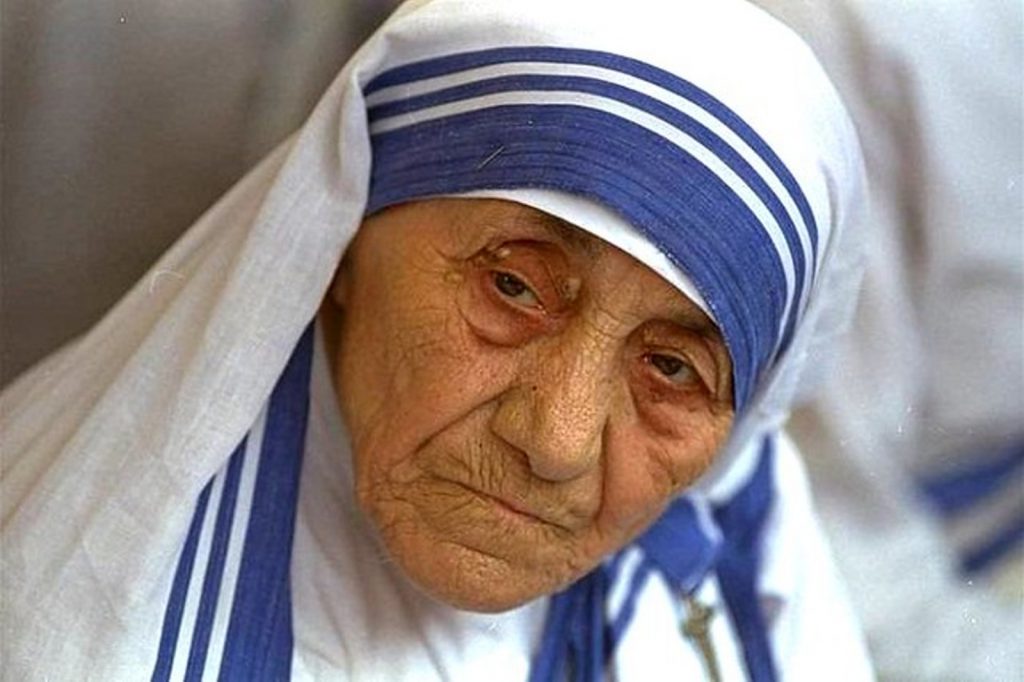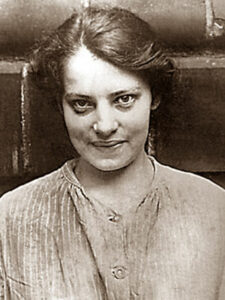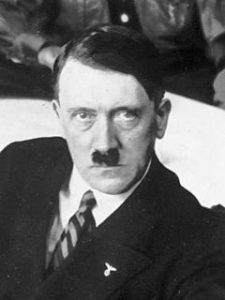On September 10, 1946, Mother Teresa felt her second vocational calling. She had been doing missionary work with the Loreto Sisters for eighteen years. But on this day, she felt what she called “a call within a call.” It was the moment when she received a request from God to do more for people in need. She wanted to start her own congregation for the people living in the slums, who often had a spirit of poverty and happiness. Although Mother Teresa wanted to start her own congregation and leave the Loreto school in Darjeeling, India to go to Calcutta, she wanted to keep her vows. Father Van Exem would call this day “Inspiration Day,” or more accurately, “Inspirations Days.”1 Father Van Exem was the person Mother Teresa trusted to help her satisfy her vision, and he later became the most important person when communicating information about Mother Teresa’s request to Archbishop Perier. So what led Mother Teresa to this point of decision in her life?
Mother Teresa, born Agnes Gonxha Bojaxhiu, was a devoted woman who spent her life helping others. At the age of twelve, she received her first “call” from God and found herself drawn to the religious life.2 At the age of eighteen, she decided to join the convent, and it was then that she became Sister Teresa. Mother Teresa was raised in a Catholic family and both of her parents were people of faith, which brought her closer to her faith and to her desire to help others. Skopje, the birthplace of Mother Teresa, was not a place where young women often entered the convent. When she made the decision to do so, it was a surprise to all of her family, especially because she would move to a distant place where she could focus on her service.3 Moving to Darjeeling was the beginning of Mother Teresa’s legacy.
Mother Teresa’s second call, to go to Calcutta, was a message that she felt was unambiguous. She stated, “I was to leave the convent and help the poor while living among them. It was an order. To fail would have been to break the faith.”4 After September 10, 1946, Mother Teresa experienced a retreat, during which she grew deeply engrossed in her prayers. While she was away for this time of silence, prayer, and reflection, she often wrote her thoughts on paper, which was later received by Father Van Exem. Mother Teresa’s vision was not going to be easy to accomplish. She wanted to leave the Loreto Order while keeping her vows, which was a decision that had to be approved of by the Archbishop. As weeks went by, Mother Teresa continued to pray and her vision remained the same. She wanted to live in the slums and help the less fortunate. The only person who knew about Mother Teresa’s call at the time was Father Van Exem, and his response was that she should continue to pray until January 1947. He then directed her to write a letter to the archbishop, and Father Van Exem offered to talk to him directly to get a response to the request.5

The archbishop’s first response was not favorable. He did not understand how a priest could encourage a nun to leave the convent, but he did not claim to know what God’s will was. Besides, Calcutta already had a charity order dedicated to the poor. If the archbishop was to approve her decision, it would seem like an irresponsible decision to let a nun live by herself in the slums of India.6 There were several risks involved in Mother Teresa’s request. During that time, India was suffering from religious violence. Indians believed that all European people, including priests and nuns, were bad influences on the people.7 Although Mother Teresa’s intentions were pure, the archbishop still denied her permission, and he did not authorize sending her application to Rome for a year.
Mother Teresa’s response to this was expected. She did not accept the decision and sent Father Van Exem to talk to the archbishop again, but the archbishop gave the same response. Deciding to accept his decision, Mother Teresa focused on prayer and did not tell anybody about her plans. Only Father Van Exem knew, not her Loreto superiors, nor the Calcutta priests who were close friends with Mother Teresa.8 As time went by, they both knew that it was not going to be long before someone noticed Mother Teresa’s plan to leave Darjeeling. Due to Mother Teresa’s talks with the spiritual director, her superiors became suspicious, but they did not catch on. Soon, it became known that Mother Teresa was transferring to Asansol, which was about three hours away from Calcutta. Father Van Exem believed he was not going to be involved in Mother Teresa’s mission after her transfer, but he received a big surprise when the archbishop sent him a letter ordering him to continue being her spiritual guide. While Mother Teresa was in Asansol, she continued teaching children geography and preparing them for their first communion. Mother Teresa was happy and she continued writing letters to Father Van Exem, but it still wasn’t her end goal.
After six months, Mother Teresa was taken to Calcutta at the request of Archbishop Perier. His explanation for this change was that he had “serious reasons.” When this decision was made, the archbishop fell ill and continued to insist that Mother Teresa wait a whole year before making a permanent decision. Due to his illness, Mother Teresa prayed for him to get better. If it did happen, she would use that as her motivation to complete her missionary work. Archbishop Perier recovered from his illness and Father Van Exem claimed that it was a sign for Mother Teresa to start her work in Calcutta.9 The archbishop’s illness can be considered an important moment in Mother Teresa’s journey. At first, he was persistent in his belief that allowing Mother Teresa to start her own congregation would be an act of rebellion. After he recovered, he had a change of heart about Mother Teresa’s request.
Without revealing Mother Teresa’s name, the archbishop consulted Father Henry, a priest in the Loreto Order, about the possibility of a Mother working in the slums of Calcutta. Father Henry believed it was a good idea. After this consultation, the archbishop also went to the General of the Society of Jesus (Jesuits) and to a specialist on Canon Law in Rome. In January 1948, Mother Teresa wrote a letter to the archbishop, once again requesting permission to leave the Loreto Order. In the letter’s response, she received permission and was advised to talk to her superiors in the Loreto Order instead of writing directly to Rome. Father Van Exem then suggested that she request an indult of exclaustration, which would allow her to leave the convent and keep her religious vows, but she would still have to answer to the archbishop.10
The archbishop had a different idea. He wanted her to request an indult of secularization, which would mean that when she left the convent of Loreto, she could never return. After Father Van Exem explained the differences between the two options of indult, Mother Teresa’s first choice was the indult of exclaustration. This was the obvious choice, because it allowed her to do what she had wanted since the beginning: keep her vows, but do her work in Calcutta. When the archbishop read her letter, he crossed out the word “exclaustration” and told Mother Teresa to trust the Mother general. Mother Teresa, trusting what the archbishop had told her, then requested an indult of secularization instead.11 With the help of the archbishop, this final letter was sent to the head of the Loreto Order.

About a month later, in February 1948, Father Van Exem was told to go the archbishop, and that is when he received what would become the second most important notice that Mother Teresa would receive. The content of the letter included permission to write a letter to Rome and apply for the indult. The letter also told her that she should not tell any of her superiors in the convent and that the archbishop’s permission was enough. Mother Gertrude, the Mother General of the Calcutta Order, specified that she should not request the indult of secularization, but instead, the indult of exclaustration.12
Archbishop Perier insisted that the application to Rome should go through him since he was well known in Rome. When Mother Teresa was informed that she was going to write the letter to Rome, her first response was that she did not know how to put it into words. As directed by the Mother General, Mother Teresa applied to Rome with the help of the archbishop, but he insisted that she applied for the secularization and corrected the letter Mother Teresa had written. In mid-February the letter was sent, accompanied by other documents in which the archbishop supported Mother Teresa’s mission and explained some of the work that she had already done.13

On April 12, 1948, Mother Teresa was granted permission to leave the Loreto Order for one year. She was not granted the indult of secularization, but she had permission to leave with the indult of exclaustration.14 Father Van Exem was the person to notify her, and before receiving the news, she went to pray at the convent chapel. When she received the news, her first reaction was to ask if she could leave to the slums in that very moment. Nevertheless, Mother Teresa had to sign some paperwork to confirm her transfer. She would now no longer be a Loreto nun.15
On August 16, Mother Teresa changed her habit to what would later became the official habit for her congregation, leaving behind what she had worn for over twenty years.16 After leaving Darjeeling, she went to Patna, where she would train and learn about medicine with the Medical Mission Sisters. During her time learning about medicine and different diseases, she would encounter the people who would later work with her in the slums. When the archbishop and Father Van Exem were sure that Mother Teresa was ready after her training, they started looking for a place for her to live in Calcutta. The most suitable place for Mother Teresa was with the Little Sisters of the Poor.17
As she took her place in Calcutta, Sister Teresa became Mother Teresa. It would not be until December 1948, after an exchange of letters between Archbishop Perier, Father Van Exem, and Mother Teresa, that Mother Teresa would be able to open a school with no money or supplies, but with a few children willing to learn. Due to the work of Mother Teresa, the people gave the school the nickname of “The Missionaries of Charity,” which became the official name of her congregation.18
- Robert Serrou, Teresa of Calcutta: A Pictorial Biography (Maidenhead, England: McGraw-Hill, 1980), 38. ↵
- Kathryn Spink, Mother Teresa: A Complete Authorized Biography (New York: HarperCollins, 1998), 23-43. ↵
- Gëzim I. Alpion, Mother Teresa: Saint or Celebrity? (London: Routledge, 2007), 165. ↵
- Kathryn Spink, Mother Teresa: A Complete Authorized Biography (New York: HarperCollins, 1998), 22. ↵
- Kathryn Spink, Mother Teresa: A Complete Authorized Biography (New York: HarperCollins, 1998), 25. ↵
- Kathryn Spink, Mother Teresa: A Complete Authorized Biography (New York: HarperCollins, 1998), 26. ↵
- Gëzim I. Alpion, Mother Teresa: Saint or Celebrity? (London: Routledge, 2007), 200-201. ↵
- Kathryn Spink, Mother Teresa: A Complete Authorized Biography (New York: HarperCollins, 1998), 27. ↵
- Kathryn Spink, Mother Teresa: A Complete Authorized Biography (New York: HarperCollins, 1998), 28. ↵
- Kathryn Spink, Mother Teresa: A Complete Authorized Biography (New York: HarperCollins, 1998), 28. ↵
- Kathryn Spink, Mother Teresa: A Complete Authorized Biography (New York: HarperCollins, 1998), 29. ↵
- Kathryn Spink, Mother Teresa: A Complete Authorized Biography (New York: HarperCollins, 1998), 29. ↵
- Kathryn Spink, Mother Teresa: A Complete Authorized Biography (New York: HarperCollins, 1998), 29-30. ↵
- Kathryn Spink, Mother Teresa: A Complete Authorized Biography (New York: HarperCollins, 1998), 30. ↵
- Kathryn Spink, Mother Teresa: A Complete Authorized Biography (New York: HarperCollins, 1998), 31. ↵
- Kathryn Spink, Mother Teresa: A Complete Authorized Biography (New York: HarperCollins, 1998), 31. ↵
- Kathryn Spink, Mother Teresa: A Complete Authorized Biography (New York: HarperCollins, 1998), 34. ↵
- Kathryn Spink, Mother Teresa: A Complete Authorized Biography (New York: HarperCollins, 1998), 35. ↵



57 comments
Sherisa Orozco
I enjoyed reading this article. It was very descriptive. Growing up, Mother Teresa was a figure I always looked up to. Mother Teresa was a figure of charity work putting others before her. Through her experience, she never gave up on helping others. This article made a great showing of this in a detailed manner showing her willingness and story to others who may not know her.
Oscar Ortega
A very nicely written piece. Mother Theresa’s reputation precedes her, but the surprisingly long road it took to get there just in terms of doing the paperwork to be given permission to do so is quite an interesting perspective of her story. A reminder that every story has a phase during which one has to be prepared to do great things, and can’t simply jump headfirst into anything, even if it is a calling or will be their life’s work. Fantastic job.
Madeline Chandler
This is such a well written engaging article. Not only was it a highly informative but really showed the emotion and characteristics of a true Christian. Mother Teresa is a name that has not only influenced the Catholic Church but she has impressed upon the Christian faith, India, and has globally shown people the definition of good. Her admirable faith, leadership, and love for others has shown the world God really works for good and uses His people for good. Great job, and Mother Teresa is a name that shows devoted belief in Jesus Christ.
Davis Nickle
Mother Teresa acts as a paragon of humanity and should be a person that not just Catholics, but all people strive to be like. I’m sure that many people have heard about Mother Teresa but I doubt that many, myself included, new about the strife and risks that she took when trying to fulfill her holy mission to Calcutta. Despite all of these things she persevered and kept faith and eventually got to fulfill her perceived duty. I’m happy that I got to read this article because it helped inform me of such a great figure’s story.
Andrea Degollado
As someone that grew up in a religion based house hold, Mother Teresa is a name i would hear often. I believe the story of Mother Teresa is completely inspiring and admirable, she did what she believed and she believed in Gods will. I think this article does a great job in informing those who didn’t know about Mother Teresa, what she was really all about. Its a very well written article and provides alot of detail. Good job.
Kennedy Arcos
I have always looked up to Mother Teresa and her work. I was introduced to her and her mission at a very young age by my mother. Mother Teresa was such an inspirational and hard working woman. From everything that I’ve learned about her it’s that she was devoted and selfless. This article was so heartwarming and it truly shows how amazing Mother Teresa was.
Michael Esparza
I have always loved the Mother Teresa’s story. I have always admired how she persevered and continued to pray and work towards what she believed Gods will was even when she was told no. She continued to do amazing things in Calcutta even though it took her a while to get there. This was an amazing article because it had gone into detail on the process for Mother Teresa to get their and a lot of people are unaware of that part of the story.
Juan Arceo
Congratulations on your nominations for this article. I can say that I have had some background knowledge on Mother Teresa since I am catholic but this article opened up my eyes towards her origin and how she got to where she wanted to be. It is interesting to see that she had her “calling” at the young age of 12 since most people are way older and are still uncertain as to what it is that they really want to do. I really enjoyed reading the article.
Briana Montes
Very well written article. Growing up I have learned a few things about Mother Teresa but I never really knew much about her background. I found it so inspiring how she was such a brave woman. This article was very heartwarming and inspirational. It amazed me how she found her calling at such a young age. She was such. kind soul and very inspiring to people still today.
Thalia Romo
The introduction of this article does a great job at introducing the character behind the main individual. It really caught my attention and drew me in to understand what could have led Mother Teresa to better others. I believe that Mother Teresa was a strong and very caring individual and that really shows through her acts that she committed throughout her life. I find it interesting that at one point she was going back and forth needing to get permission from different people in order to do what she truly wanted and still be accepted.